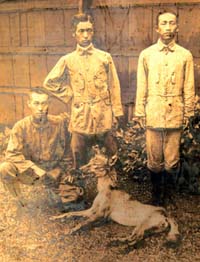
March 30, 2011
Japanese Wolves Part 2- The Yamainu
By Brent Swancer
In the first installment of this Japanese wolf series, I introduced the Honshu wolf and we looked at the events leading to its supposed demise. Let us further explore the story of the wolves of Japan.
The date of extinction of the Honshu wolf has long been set at 1905, with the death of a specimen killed in Nara prefecture on Honshu island, Japan. Did the Honshu wolf survive past this date and thus defy the extinction orthodoxy?
In August of 1910, five years after the death of the so-called “last one,” a strange canid was shot and killed at the Matsudaira agricultural station in rural Fukui prefecture. At first the animal was thought to be a feral dog or perhaps even an escaped Korean wolf from a zoo, but the following day zoo staff examined the carcass and refuted this, saying that the animal looked very much like a presumably extinct Honshu wolf. This was a somewhat controversial stance, as many in Japan held firmly to the 1905 extinction date.
Unfortunately, the preserved carcass of this specimen was destroyed in a fire during the years of the war leaving merely a photograph and journal entries of the event to go on. For decades, the identity of the mysterious canid killed in 1910 was debated, the identity of the animal made more mysterious by the lack of any body to examine. There were many who disagreed with the initial analysis done by the zoo personnel at the time, pointing to perceived physical differences between the photographed animal and the Honshu wolf.

The alleged Honshu wolf shot at the agricultural station
In the early 2000s, Japanese zoologist and wolf expert Yoshinori Imaizumi, former head of animal studies at the National Science Museum, and his colleague Mizuko Yoshiyuki, also of the National Science Museum, did a thorough and detailed analysis of the photograph as well as journal entries made of the event at the agricultural station. The photograph was meticulously examined and the data on the animal recorded in the journal entries was carefully compared to known information on the Honshu wolf. This was perhaps the most thorough and scientific examination of the event yet.
After careful consideration of the evidence on hand. The two scientists came to the conclusion that the pictured animal was indeed a Honshu wolf. They argued that the physical characteristics of the pictured animal, such as its coloration, the rounded tail, and body dimensions all fit in with the Honshu wolf. The low body weight, which was recorded as 18.75 kg in a journal entry by personnel at the Matsudaira station, also fit in with Honshu wolves. In addition, no escaped Korean wolves had been reported at the time.
It would appear that the extinction timeline should have been more thoroughly revised in light of these findings, yet debate continues and most widely available information still lists the Honshu wolf as becoming extinct in 1905. Is there a chance that the Honshu wolf survived until 1910? It certainly appears that this may be the case. But what of the wolves’ survival beyond that? Could it have even perhaps survived into the present?
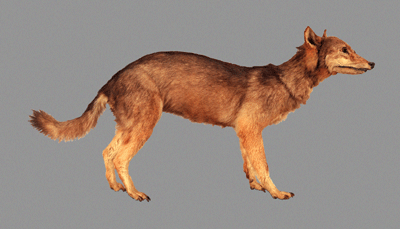
Over the years, sightings and circumstantial evidence have suggested that the Honshu wolf may very well have eked out an existence in the mountainous Japanese wilderness. From the early 1900s all the way up until well into the 2000s, alleged Honshu wolf sightings, photos, and even reports of captures or carcasses have continued to pop up from time to time. Let’s look at a few standout cases, although this list is by no means comprehensive.
-In 1934 a group of foresters hunting deer claimed to have come across not one, but a whole pack of Honshu wolves, comprised of 5 or 6 individuals.
-In 1936, a villager on the Kii peninsula claimed to have actually captured a live wolf cub, however the man was reported to have released it back into the wild out of fear the mother wolf would come looking for it.
-The 1940s and 50s saw a sharp increase in wolf sightings. This spate of sightings is thought to be due in part to the huge conscription effort that was going on in Japan in the years around the war. Consequently, a large number of people were leaving the countryside during this time frame, which could have had led to a population boost for the wolves brought on by decreased hunting and increased populations of prey species.
-In 1964, a Mr. Kenji Yanai was mountaineering with his son and a co-worker near Ryogami Mountain when they heard a series of strange howls. Soon after, they came across a lone wolf, which is reported to have studied them for a moment before dashing into the forest, leaving its kill of a small hare behind in its escape.
– In 1966, a photograph was taken of an alleged Honshu wolf by a Hiroshi Yagi on a forest road in Saitama prefecture. The photo was inconclusive, and has been criticized as being a photo of nothing more than a dog.
– In the 70s, there was purportedly a carcass of an apparent Honshu wolf brought in to researchers for study. The body is said to have disappeared and it is unclear of what ever became of it or of any analysis done on it.
-Between the years of 1908 and 1978, Aomori and Oita prefectures were the source of at least 26 sighting reports of Honshu wolves.
-In 1998, there was a flap of mystery canid sightings in Chichibu, in the mountains not too far from Tokyo. On many occasions the mysterious canids were seen running through brush, across roads, through yards, and heard yipping or howling. One resident complained that a wolf-like animal had attempted to attack chickens he kept on his rural property.
– On July 8, 2000, a high school principal by the name of Satoshi Nishida photographed an alleged Honshu wolf in Kyushu while he was hiking. The animal photographed was a medium sized canine that was grey and white in color, with orange coloration on its legs as well as behind the ears. A series of photographs were snapped from 10 to 15 feet away before the animal disappeared into thick underbrush. I was unable to find images of these photos to post here, but they are of grainy quality and fairly inconclusive. Nevertheless, they were compelling to the previously mentioned Japanese zoologist and wolf expert, Yoshinori Imaizumi.
-In 2006, an eyewitness account was relayed to me personally by a Japanese woman who claimed to have seen two of the animals while hiking near her hometown in Wakayama prefecture. As she was hiking, the woman claimed to have heard a commotion coming from the brush to the side of the trail. The woman said that as she approached, she noticed two animals that she at first took to be Shiba dogs wrestling around in the bushes. However, on closer inspection, she came to the conclusion that something about them looked off, not quite like any type of dog she was familiar with. The animals seemed to be fighting over the carcass of some small animal, oblivious to her approach. When they noticed the woman, one of the canids darted away with the carcass and was quickly followed by the other.

Sightings are not the only evidence on offer. In many areas, alleged wolf tracks have been found, as well as purported wolf hairs and scat. Some shrines also claim to have pelts or other relics gathered from Honshu wolves that died after their supposed extinction date. For instance, in 1994 a shrine in Tottori prefecture was found to possess a wolf specimen that is thought to have possibly died as recently as the 1950s. An alleged wolf pelt was also found in the possession of a man who claimed it was killed sometime in the 70s, although this has not been confirmed.
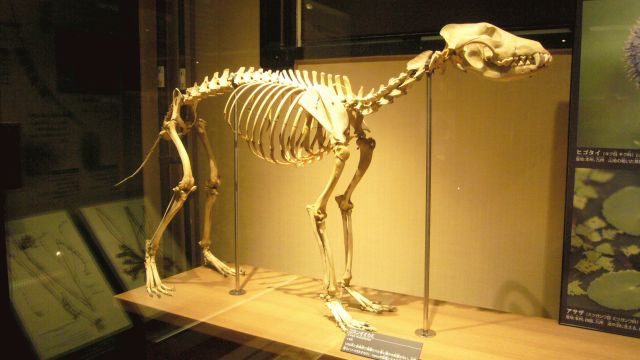
A preserved Honshu wolf skeleton at a museum
Occasionally wolf howls are reported as well. In 1994, for instance, at least 70 people reported wolf-like howls around the Kii peninsula, an area long considered a major hot spot for Honshu wolf sightings and activity.
So what is the chance that this evidence amounts to anything? Is it possible that Honshu wolves are still roaming the Japanese mountains?
The habitat in Japan is certainly able to sustain a population of wolves. Although the population density of Japan is high, this data can be misleading. The terrain is largely mountainous and forested, with the bulk of the human population concentrated into major urban centers on the coastal plains. Something like 90% of Japan’s population inhabits only around 10% of the actual land area. Looking at population density statistics on paper does not do justice to just how much rugged, unpopulated wilderness there really is in this island nation.
The forests of Japan abound with abundant prey species, to the point that animals such as deer and wild boar have become serious pests in many areas. The ecosystem would be quite comfortable for a predator such as the Honshu wolf. In fact, the wolf’s biological niche in Japan has never really been filled since its disappearance. Other Japanese predators are geared towards smaller prey, and even the closest thing to the wolves, the raccoon dog, or tanuki, does not prey on the same animals the wolves once did. The Honshu was a keystone predator and as such its apparent disappearance has had a negative effect on the Japanese ecosystem. Not only is the habitat in Japan suitable for sustaining the wolves, it sorely needs them.
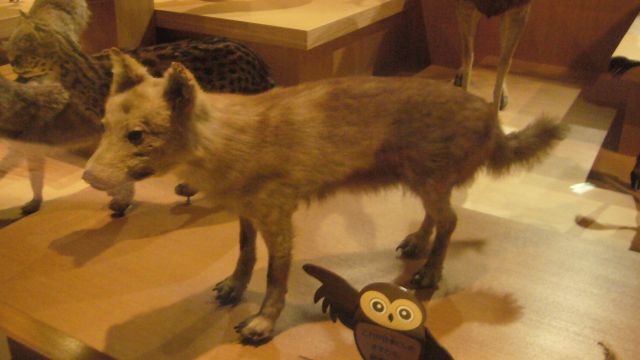
It seems at least possible that considering the vast swaths of sparsely populated mountain wilderness, small populations of these wolves could stay adequately hidden from people. While these areas are further encroached upon by urban centers, much of Japan’s wilderness remains remote and an increasing number of people are moving away from rural areas to pursue a different life in the bustling cities.
Regardless of the potential for the habitat to support them, there are still certain problems that we are faced with when reviewing the evidence for the continued survival of the Honshu wolf. Physical evidence allegedly left behind by the wolves has so far been circumstantial at best. Tracks or scat could have been left by feral dogs or even domesticated ones that are allowed to roam. The dogs in many rural areas of Japan are often allowed to wander off into the forests at will, or live in an almost semi-feral state, which could result in canine tracks or droppings far out in the woods.
Attempts at DNA testing conducted on evidence such as hairs or preserved physical evidence have run into problems as well. Mitochondrial DNA testing has failed to clear up the identity of alleged wolf hairs, and DNA testing of preserved evidence such as scraps of pelts or bone have so far produced similarly inconclusive results.
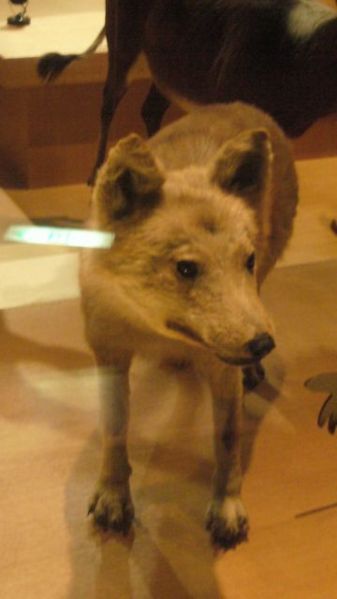
Furthermore, obtaining a good sample of Honshu wolf genetic material from the handful of known mounted specimens for comparison has presented its own challenge as the harsh chemicals used in the taxidermy process can produce faulty results. We simply don’t even have a completely reliable, solid sample of Honshu wolf genetic material with which to compare in the first place.
The problem is further compounded by the fact that some Japanese breeds of dog such as the Shiba inu, Akita inu, and Shikoku inu (note that inu simply means “dog” in Japanese) bear a strong resemblance to Honshu wolves and the two are thought to be somewhat close, both phenotypically and genetically, to Honshu wolves. This is especially so if hybridization has occurred to any significant degree.
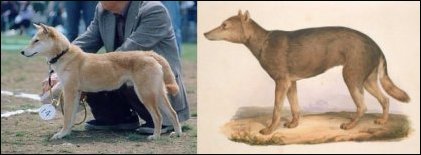
Jomon dog compared to Yamainu
The “Pariah” dogs that followed human migrations to Japan during the Jomon period (approximately 8,000 to 200 B.C.), became the basis for most Japanese dog breeds. The Shiba inu, for example, is thought to have changed very little from the hunting dog early Jomon settlers brought with them.
It is thought that these Japanese breeds have possibly intermittently interbred with Honshu wolves over time to various degrees depending on who you ask. Intentional interbreeding is not so far fetched, as these early settlers certainly valued certain wolf-like characteristics in their dogs, such as hunting prowess and a strong family bond (pack mentality). Unintentional hybridizatrion also could have occurred.
This possible genetic similarity between Japanese dog breeds and Honshu wolf, combined with the already strong genetic plasticity of canines in general, potentially makes it difficult to conclusively prove anything through DNA results.
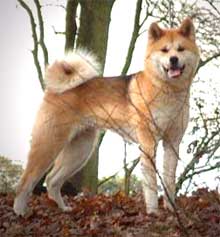
Akita inu

Shiba inu
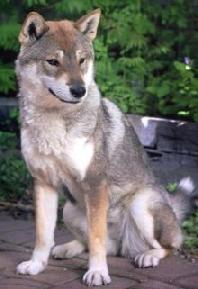
Shikoku inu
Regardless of the specific genetic connections between Japanese dog breeds and the Honshu wolf, the clear physical similarities between them certainly could at least have an effect on the credibility of sightings reports. The Shiba inu in some ways look quite a bit like the Honshu wolf, as does the Shikoku inu breed and to a somewhat lesser extent the larger Akita inu.
These dog breeds could perhaps be mistaken for the wolves under the right conditions. Even in the clear photos I’ve provided here under ideal conditions, you can see the superficial resemblance between these dog breeds and the Honshu wolf is apparent. It isn’t too hard to imagine someone coming across a feral or wandering specimen of one of these dogs out in the middle of the woods or only fleetingly, and coming to the conclusion that they had seen a wolf.
Is it possible that all of the eyewitnesses are merely seeing dogs?
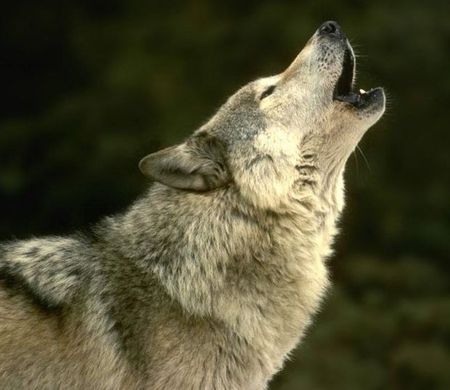
The reports of wolf howls are a bit harder to dismiss, yet there is the slight possibility that certain dog sounds could be mistaken as being from something like a wolf. The Shiba inu and some other Japanese breeds for example are known to produce high pitched noises and screams rather than barking or typical dog sounds. The Hokkaido inu breed also howls very much like a wolf. Could these have perhaps be misconstrued as “wolf noises” by a startled witness out in the woods?
There are no recordings of Honshu wolf vocalizations, so we are without a basis of comparison. We are left with a compelling mystery. What is producing the howls that people are hearing and claiming to be those of wolves?

The timber or gray wolves (Canis lupus) of North America (above and below) are found in a variety of color forms. Could the same be true of Japanese wolves? And what overlap is there in their howls?

There have been attempts to further investigate these alleged wolf howls. In 1995, a team ventured into the wilderness of the Kii peninsula with recordings of howls from Canadian gray wolves with the intent to elicit howls in response from any Honshu wolves that may still be out there. After several nights of continuously playing the recordings, the team failed to get any answering howls at all.
The following year, in 1996, a similar experiment was conducted in Saitama prefecture. The team made meticulous recordings of the forest sounds after regular blasting of grey wolf calls, yet close scrutiny of the tapes turned up no answering wolf howls. It would be interesting to see if further experiments of this kind turn up anything, but so far there has been nothing but silence.
Where are the Honshu wolves? Are they still out there prowling Japan’s wilderness, or have they been regulated to museums, Shinto wolf shrines, and legends? Do they still pierce the night with their howls, or are they forever quiet? If we continue to search, will we find wolves, or merely stories and anecdotes of a long vanished animal?
The mystery remains.
Stay tuned for the final installment of my Japanese Wolves series, as we discover that the Honshu wolf was not the only variety of wolf to inhabit Japan.
About mystery_man
Filed under Cryptid Canids, Cryptomundo Exclusive, Cryptotourism, CryptoZoo News, Cryptozoology, Evidence, Eyewitness Accounts, Mystery Man's Menagerie